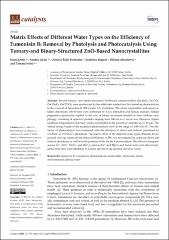| dc.contributor.author | Jevtić, Ivana | |
| dc.contributor.author | Jakšić, Sandra | |
| dc.contributor.author | Šojić Merkulov, Daniela | |
| dc.contributor.author | Bognár, Szabolcs | |
| dc.contributor.author | Abramović, Biljana | |
| dc.contributor.author | Ivetić, Tamara | |
| dc.date.accessioned | 2023-02-17T10:23:01Z | |
| dc.date.available | 2023-02-17T10:23:01Z | |
| dc.date.issued | 2023 | |
| dc.identifier.citation | Jevtić, I.; Jakšić, S.; Šojić Merkulov, D.; Bognár, S.; Abramović, B.; Ivetić, T. Matrix Effects of Different Water Types on the Efficiency of Fumonisin B1 Removal by Photolysis and Photocatalysis Using Ternary-and Binary-Structured ZnO-Based Nanocrystallites. Catalysts 2023, 13, 375. https://doi.org/10.3390/ catal13020375 | en_US |
| dc.identifier.issn | 2073-4344 | |
| dc.identifier.uri | https://repo.niv.ns.ac.rs/xmlui/handle/123456789/594 | |
| dc.description.abstract | Several ternary- and binary-structured ZnO-based nanocrystallites (Zn2SnO4, Zn2TiO4,
ZnO/SnO2, ZnO/TiO2) were synthesized by the solid-state method and first tested as photocatalysts
in the removal of fumonisin B1 (FB1) under UV irradiation. The phase composition and nanocrystalline
dimensions (50–80 nm) were confirmed by X-ray diffraction and Raman analyses. Similar
preparation procedures applied in the case of binary structures resulted in their uniform morphology
consisting of spherical particles ranging from 100 nm to 1 μm in size. However, higher
synthesis temperatures of ternary oxides contributed to the growth of particles up to 10 μm. The
optical energy bands of the examined photocatalysts were in the range of 3.08–3.36 eV. The efficiency
of photocatalysis was compared with the efficiency of direct and indirect (sensitized by
UV/H2O2 or UV/S2O82−) photolysis. The matrix effect of the different water types (Danube River,
ground, and tap water) on the removal efficiency of FB1 was investigated by applying direct and
indirect photolysis, as well as in the presence of the Zn2SnO4 photocatalyst. The effects of inorganic
anions (Cl−, NO3−, HCO3− and SO42−), cations (Ca2+ and Mg2+), and humic acid were also investigated,
since they were identified as a major species in tap, ground, and river water. | en_US |
| dc.description.sponsorship | This research was supported by the Science Fund of the Republic of Serbia (Grant No.
7747845, In situ pollutants removal from waters by sustainable green nanotechnologies-
CleanNanoCatalyze) and by the Ministry of Science, Technological Development and Innovation
of the Republic of Serbia (Grant No. 451-03-68/2022-14/200125). | en_US |
| dc.language.iso | en | en_US |
| dc.source | Catalysts | en |
| dc.subject | fumonisin B1 | en_US |
| dc.subject | mycotoxin | en_US |
| dc.subject | photocatalysis | en_US |
| dc.subject | metal oxides | en_US |
| dc.subject | photolysis | en_US |
| dc.subject | matrix environmental and tap water | en_US |
| dc.title | Matrix Effects of Different Water Types on the Efficiency of Fumonisin B1 Removal by Photolysis and Photocatalysis Using Ternary-and Binary Structured zno-Based Nanocrystallites | en_US |
| dc.type | Article | en_US |
| dc.identifier.doi | 10.3390/catal13020375 | |

